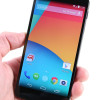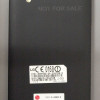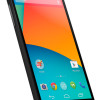Review: Google Nexus 5
Screen
The N5's screen measures 5 inches across the diagonal and has 1920 x 1080 pixels for full HD. LG favors in-plane switching (IPS) LCD panels, and the N5's is no different. I like the screen a lot. It is probably my favorite feature of the N5. Not only is it large and bright, but the resolution makes everything on the screen crisp and smooth. Colors look accurate to my eyes, but - like many LCDs - there's a pretty steep drop in brightness when the phone is tilted side-to-side. But it is still bright enough for use outdoors under the sun.
Signal
We tested the Nexus 5 on both AT&T and T-Mobile networks. It performed admirably on both.
AT&T: Across New Jersey, Pennsylvania, and New York, the Nexus did a great job connecting to AT&T's network. It held on to the network firmly. It switched between LTE and HSPA seamlessly. It connected all calls on the first attempt and never dropped any calls during the review period. It did miss a couple of calls when in a fast-moving car in rural Pennsylvania, though. Data speeds were decent under most network conditions and appreciably quicker when LTE was available.
T-Mobile: I tested the Nexus 5 on T-Mobile's HSPA and LTE networks in New Jersey and New York City. It performed on par with other T-Mobile devices in that it always remained connected to the network and did well when it came to connecting and maintaining phone calls. Data speeds varied a lot. When T-Mobile's signal was weak (1 bar,) the N5 had trouble loading web pages, but it sped right up once network conditions improved a bit.
The Nexus 5 is quite rare in that one variant (the D820 sold in the U.S.) can connect to all of the various LTE frequency bands used by AT&T, T-Mobile, and even Sprint. (A second variant — the D821 — has better support for LTE networks in the rest of the world, including Canada.)
Sound
In general, call quality was pretty good on both AT&T and T-Mobile's networks. The earpiece produces calls that are mostly free of stray noises, and the volume was very good, though short of excellent. I was able to hear calls in most environments, and setting the volume all the way up meant I could hold a conversation despite jackhammers in the background. It wasn't loud enough to overcome the music and chatting in a noisy bar, though. I appreciate that setting the volume up all the way didn't distort the sound. The speakerphone also rates well. Quality is slightly above average and the volume is enough for your home or enclosed office. I wish the speakerphone produced more volume for noisy environs, but it suffices. Ringers and alert tones could definitely be louder. They can be hard to hear when you're out in the world, even when set all the way up. The vibrate alert is average.
Battery
In a word, inconsistent. After a week of testing on both AT&T and T-Mobile's LTE networks, I can say the Nexus 5 doesn't quite make it through a full day. You might get 12 hours of real-world usage out of it, and maybe a bit more if you skimp. It is frustrating that Google would put a 2,300 mAh battery in a device that has a 5-inch FHD screen and a quad-core processor, especially when the LG G2 — on which the N5 is based — has a 3,000 mAh battery. The N5 battery can drain fairly quickly even when not being used, so you need to be careful and monitor your usage. I recommend carrying an external battery pack or a spare charger.


 Use Different Camera Apps to Improve Photo Quality
Use Different Camera Apps to Improve Photo Quality
 Hands-On: Google Nexus 5
Hands-On: Google Nexus 5
 FCC Reveals Photos of Possible Nexus Made by LG
FCC Reveals Photos of Possible Nexus Made by LG
 Google Nexus 5 Now Available in Red
Google Nexus 5 Now Available in Red
 Google Reveals Nexus 5 with Android 4.4 KitKat
Google Reveals Nexus 5 with Android 4.4 KitKat
 LG Nexus 5
LG Nexus 5











